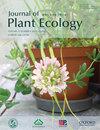优势种对藏北草原群落稳定性的形成起主导作用
IF 3.9
2区 环境科学与生态学
Q2 ECOLOGY
引用次数: 3
摘要
优势物种可以强烈影响生物条件并与其他物种相互作用,因此是群落动态和生态系统功能的重要驱动因素,特别是在高寒草原的应激环境中。然而,优势种对不同生态系统群落稳定性的影响尚不清楚。研究了藏北不同物种组成和优势度的4种高寒草原(高寒草甸、高寒草甸草原、高寒草原和高寒荒漠草原)地上生产力和群落稳定性的时间稳定性(2014-2020年)机制。结果表明,高寒草甸的群落稳定性显著高于其他3种草地。这种差异主要归因于高寒草甸较高的补偿效应和选择效应。此外,优势种通过增加优势种稳定性和物种非同常性对群落稳定性产生强烈影响。物种丰富度对群落稳定性影响不大。研究结果表明,优势种作为基础种,可能在高寒草原群落稳定性的形成中起主导作用,强调了在环境波动日益加剧的脆弱生态系统中,保护优势种对于稳定生态系统功能的重要性。本文章由计算机程序翻译,如有差异,请以英文原文为准。
Dominant species play a leading role in shaping community stability in the northern Tibetan grasslands
Abstract Dominant species may strongly influence biotic conditions and interact with other species, and thus are important drivers of community dynamics and ecosystem functioning, particularly in the stressed environment of alpine grasslands. However, the effects of dominant species on the community stability of different ecosystems remain poorly understood. We examined the mechanisms underlying temporal stability (2014–2020 year) of aboveground productivity and community stability in four alpine grasslands (alpine meadow, alpine meadow steppe, alpine steppe and alpine desert steppe) of the northern Tibetan with different species composition and dominance. Our results showed that community stability was significantly higher in the alpine meadow than in the other three types of grasslands. This difference was mainly attributed to the higher compensatory effect and selection effect in the alpine meadows. Furthermore, dominant species strongly affected community stability by increasing dominant species stability and species asynchrony. However, species richness had little effect on community stability. Our findings demonstrate that dominant species, as foundation species, may play leading roles in shaping community stability in the alpine grasslands, highlighting the importance of conserving dominant species for stable ecosystem functioning in these fragile ecosystems under increasing environmental fluctuations.
求助全文
通过发布文献求助,成功后即可免费获取论文全文。
去求助
来源期刊

Journal of Plant Ecology
生物-植物科学
CiteScore
4.60
自引率
18.50%
发文量
134
审稿时长
3 months
期刊介绍:
Journal of Plant Ecology (JPE) serves as an important medium for ecologists to present research findings and discuss challenging issues in the broad field of plants and their interactions with biotic and abiotic environment. The JPE will cover all aspects of plant ecology, including plant ecophysiology, population ecology, community ecology, ecosystem ecology and landscape ecology as well as conservation ecology, evolutionary ecology, and theoretical ecology.
 求助内容:
求助内容: 应助结果提醒方式:
应助结果提醒方式:


